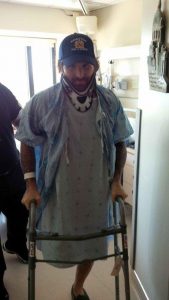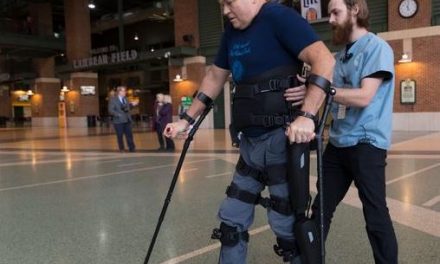Moments after the impact, the Kingston, Ont., firefighter, who had been enjoying a country ride on his Harley-Davidson, was lying at the bottom of a ditch with a broken neck, a broken back and his right leg torn off at the knee.
But he didn’t call 911. Instead, Laughlin called his own fire dispatch centre for help.
“They picked up in one ring and said, ‘Hey, Mike, how are you?’ I started to yell over and over that I was dying.”
Within 15 minutes, firefighters were at his side. They were soon followed by an ambulance and a team of paramedics, who raced Laughlin to Kingston General Hospital, where surgeons saved his life but not his right leg.
Now, two years later, after multiple surgeries, months of rehab, 10 different prosthetic legs and a whole lot of determination, Laughlin, 37, is back fighting fires.
He believes he is the only firefighter in Canada on active duty with a prosthetic leg above the knee. Working toward that accomplishment — a massive physical achievement given the demands of firefighting — is what buoyed Laughlin after each of his seven surgeries and during the long months of rehab.
“I wanted to be the first, I wanted to be the person who showed it could be done,” he says. “Without that goal of getting back on a fire truck, I don’t know how driven I would have been to get better so fast. That pushed me every day to work hard, to get back.”
Laughlin remembers doing everything right on that sunny June day in 2016 when he decided to take a late afternoon motorcycle drive on a winding country road.
He wasn’t speeding, the conditions were perfect and his mind was on the road’s upcoming twists and turns.
When the deer jumped into the side of his motorcycle, Laughlin was driving toward a 90-degree curve. Though he tried, Laughlin was unable to stop his motorcycle from skidding out of control on the gravel shoulder.
As his bike flew out from underneath him, Laughlin recalls pulling his body into a seated position to prevent his head from hitting the road. He knew from his firefighting experience that crash victims with severe head injuries often don’t survive.
But that decision came with its own consequences. Sliding into the ditch on his rear end compressed Laughlin’s neck and spine, causing multiple fractures. His right leg also caught on a rock, the force tearing the limb off at his knee.
Lying on his back, his 315-kilogram (700-pound) bike on top of him, its searing muffler burning his arm, Laughlin recalls an unsettling silence.
“It was eerie; everything slowed down and I thought, ‘This is it, I’m going to die.’ ”
Then, his survival instincts and firefighting training took over.
Using only his arms, Laughlin managed to throw his motorcycle off his body. He then noticed his mangled lower right leg, stretches of smooth white bone poking through the flesh. He lifted it out of the dirt, quickly realizing it was only attached to his body by a single flap of skin.
“When I grabbed it, I couldn’t feel anything. That’s when I knew something was really wrong.”
While he waited for help, he used his belt to make a tourniquet and wrapped it around his upper right thigh. He then realized no one travelling on the road could see him or his motorcycle deep in the ditch. To catch someone’s attention, he tossed his helmet on to the road.
Just one driver stopped, an elderly woman who struggled down the embankment and cradled Laughlin in her arms and told him it was going to be all right.
“It was like I had an angel on my shoulder for a while. It meant everything not to be alone in that ditch thinking I was going to die.”
Once Laughlin arrived at Kingston General, doctors put him in a medically induced coma, in part to help relieve his tremendous pain. Eight days later, he awoke to doctors telling him he had broken ribs, multiple compression fractures in his neck and spine and that his right leg had been surgically reattached.
At first, everyone believed the surgery had worked. But then, five days after coming out of the coma, Laughlin’s doctors told him they needed to amputate his right leg. It was infected and, even if they could halt the bacteria from spreading, it was becoming clear that a prosthetic leg would give Laughlin a better chance at returning to his active life and his job as a firefighter.
“I grieved for an hour with my family,” Laughlin recalls. “It was a shock. How was I going to live with just one leg?
“But an hour later, I was on my iPad, YouTubing the best prosthetic legs that would let me get back to work. I didn’t give myself time to say ‘poor me.’ It was more like, ‘OK, what am I going to do to get better?’ ”
Laughlin’s surgeon hoped to save his knee, which would have made for an easier recovery. But after a failed attempt, his medical team decided to amputate his right leg above the knee.
It was the right call.
 Laughlin spent one month at Kingston General. Every day, members of Kingston Fire and Rescue Services came to visit, often pulling up to the hospital in their big fire trucks. At one of their first visits they hung Laughlin’s firefighting helmet on the wall of his hospital room. It was a sign their friend and colleague would return to the job he loved.
Laughlin spent one month at Kingston General. Every day, members of Kingston Fire and Rescue Services came to visit, often pulling up to the hospital in their big fire trucks. At one of their first visits they hung Laughlin’s firefighting helmet on the wall of his hospital room. It was a sign their friend and colleague would return to the job he loved.
In the months after his motorcycle accident, Laughlin surprised everyone with how quickly he got better.
At Kingston’s Providence Care Hospital, Laughlin learned to manoeuvre his wheelchair while he waited for his back and amputated leg to heal. Two eight-inch titanium rods stabilized his broken spine and a large brace encircled his fractured neck.
Each day, he worked hard on his rehab exercises and the skills needed to live with one leg. Though he was supposed to stay for more than a month, Laughlin went home after just 2 1/2 weeks.
“No one could believe it. Getting better couldn’t happen quickly enough for me.”
Four months after his accident, Laughlin was fitted for his first prosthetic leg. Two months later, Laughlin returned to light duty at Kingston Fire and Rescue.
Though he wasn’t on a fire truck, the office job gave Laughlin a purpose, something to look forward to as he waited for a series of sores to heal on the end of his amputated leg and while he practised with a variety of prosthetic legs.
Rick Chesebrough, fire chief for the town of Smiths Falls, says firefighters from around the region were thrilled when Laughlin returned to work.
“Everybody wanted to see him recover,” says Chesebrough, who has known Laughlin for 18 years and who rode with him in the ambulance after his motorcycle accident. “Mike always knew he would make it back. From those first days in hospital, not once did he indicate that he wasn’t returning to the fire department.
“For the rest of us, the emotional roller coaster was not knowing whether that would happen. Now we know there is a happy ending to the story.”
On Dec. 18, 2017, Laughlin returned to active duty, becoming the first firefighter in Canada with a prosthetic leg above the knee. He had contacted fire halls across Canada and the United States looking for a firefighter in a similar circumstance and found just one — Brandon Anderson from Indiana.
These days, Laughlin relies on a $120,000 prosthetic leg.
“He has such fight,” says Martin Robertson, a certified prosthetist with 23 years’ experience, who has helped Laughlin with each of his different prosthetic legs. “I’ve never had someone work so hard. He’s always looking for ways to improve things.”
The prosthetic leg, developed in co-operation with the U.S. military, is waterproof, dustproof, shockproof and contains a battery-operated, computer-controlled artificial knee joint that allows Laughlin to walk, run and climb like an able-bodied person.
Robertson, of V2 Innovations Orthotics and Prosthetics in Kingston, says while the artificial knee uses sensors to know when to bend or straighten, stay stable or swing free, it doesn’t generate any force, which means Laughlin has to build up muscles in his back, thighs and remaining leg to power all of his movements.
And, he adds, a prosthetic leg doesn’t transmit sensation, so Laughlin can’t use the ground underfoot as a marker to know how and where to move his artificial limb.
“Controlling an artificial joint takes an incredible amount of focus, training and practise,” Robertson says. “Now, imagine wearing 80 or 100 pounds of gear with one and having to do everything an able-bodied firefighter has to do.”
Laughlin wears his prosthetic leg at all times while at the fire hall. A second, identical $120,000 prosthetic leg remains in his right fire boot.
When the alarm rings, Laughlin takes off the prosthetic leg he is wearing, steps into his fire boot and locks on his alternate leg, a process that takes just 45 seconds. If he didn’t have a pair of prosthetic legs, switching from a work boot to a fire boot would take five minutes — about four minutes too long to meet protocol. His insurance plans paid for both prosthetic legs.
Though it’s taken time to make other adaptations to return to firefighting, Laughlin says no hurdles remain.
He drives the trucks, helps operate the pumps and tackles any and every call that comes in.
“What we’ve all learned is that it doesn’t matter my technique as long as I get the job done.”
Laughlin has a lot of scars. The ones from his 2016 motorcycle crash are only the most recent batch.
As a kid growing up on a farm near Kingston, Laughlin always found a way to go fast, whether riding his child-size electric motorbike or, as he grew older, zooming through the mud on his dirtbikes.
Hockey, too, gave him the chance to push his limits. In high school, Laughlin was drafted into the Ontario Hockey League and briefly played for the Kingston Frontenacs. At 19, when it became clear that, though talented, he wouldn’t make it to the NHL, Laughlin became a volunteer firefighter. To him, firefighting offered both the camaraderie of a hockey locker room and the rush of playing hard on the rink.
But just after his 25th birthday, Laughlin’s adrenalin-seeking caught up with him.
In January 2007, Laughlin nearly died during a nighttime snowmobile ride across an icy lake when he mistakenly veered off the trail and crashed into a rocky island hidden in the deep snow. That accident left him with a shattered femur, broken left kneecap and broken bones in his lower left leg and left forearm. A pair of titanium plates and 33 titanium pins and screws continue to hold those bones together.
And there are other, deeper wounds.
In 2011, his longtime girlfriend died by suicide. Laughlin says the emotional pain he experienced following her death was worse than any physical pain he has had to endure.
More than once, post-traumatic stress disorder has pierced Laughlin’s natural sunny disposition. But each time anxiety or depression has touched him, Laughlin quickly sought help, halting its insidious spread.
And, just as he did on the day of his motorcycle accident, Laughlin has learned to call on the firefighting community for help. He says those ties — and the love for his job — have given him the strength to push through each of his tragedies to make it back on a fire truck.
“To us, it’s the best job in the world,” he says. “We can’t imagine doing anything else. Helping people, the chance of being a hero, that’s huge. Early in my career, I saved a woman from a fire. It’s the best feeling in the world to put your life on the line for someone.”
He says his trio of traumas haven’t got in the way of his firefighting skills. In some ways, he adds, they have made him a better firefighter because he knows what it’s like to be scared and in pain, trusting someone else to save your life.
“I can see it from the other side now, what it’s like to be that victim. When I say, ‘Hey, I understand what you are going through,’ I actually do. I think people can tell.”
Friends say that Laughlin can usually find a silver lining in even the darkest clouds. One such lining is his fiancée, Angela Clark, a nurse he met while wheeling along the halls of Providence Care Hospital in the weeks after his motorcycle accident.
Laughlin says Clark, a palliative care nurse and mother to a young daughter with Down syndrome, has given him a sense of belonging and purpose that used to only come from firefighting. They will get married on Oct. 12.
Laughlin is back riding his Harley-Davidson motorcycle. He sees no reason to stay away. To him, his 2016 accident was just that, an accident.
“On that day I did everything right and still something happened,” he says. “There are all kinds of ways to die. I’m not going to live my life being scared of the things I like to do.”
Originally published in the Toronto Star
Megan Ogilvie is a Toronto-based health reporter.




